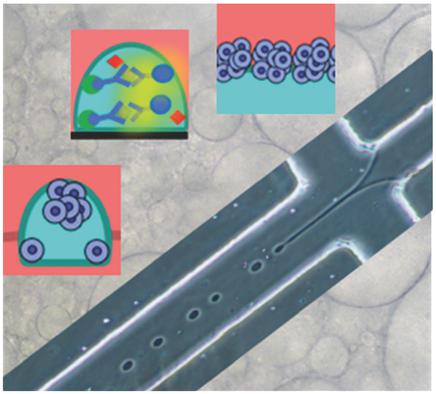当前位置:
X-MOL 学术
›
Adv. Healthcare Mater.
›
论文详情
Our official English website, www.x-mol.net, welcomes your feedback! (Note: you will need to create a separate account there.)
Emerging Biotechnology Applications of Aqueous Two‐Phase Systems
Advanced Healthcare Materials ( IF 10.0 ) Pub Date : 2017-12-27 , DOI: 10.1002/adhm.201701036 Alyne G. Teixeira 1 , Rishima Agarwal 1 , Kristin Robin Ko 1 , Jessica Grant-Burt 1 , Brendan M. Leung 1, 2 , John P. Frampton 1
Advanced Healthcare Materials ( IF 10.0 ) Pub Date : 2017-12-27 , DOI: 10.1002/adhm.201701036 Alyne G. Teixeira 1 , Rishima Agarwal 1 , Kristin Robin Ko 1 , Jessica Grant-Burt 1 , Brendan M. Leung 1, 2 , John P. Frampton 1
Affiliation

|
Liquid–liquid phase separation between aqueous solutions containing two incompatible polymers, a polymer and a salt, or a polymer and a surfactant, has been exploited for a wide variety of biotechnology applications throughout the years. While many applications for aqueous two‐phase systems fall within the realm of separation science, the ability to partition many different materials within these systems, coupled with recent advances in materials science and liquid handling, has allowed bioengineers to imagine new applications. This progress report provides an overview of the history and key properties of aqueous two‐phase systems to lend context to how these materials have progressed to modern applications such as cellular micropatterning and bioprinting, high‐throughput 3D tissue assembly, microscale biomolecular assay development, facilitation of cell separation and microcapsule production using microfluidic devices, and synthetic biology. Future directions and present limitations and design considerations of this adaptable and promising toolkit for biomolecule and cellular manipulation are further evaluated.
中文翻译:

两相水系统的新兴生物技术应用
多年来,在包含两种不相容的聚合物(一种聚合物和一种盐,或者一种聚合物和一种表面活性剂)的水溶液之间进行液-液相分离已被广泛用于各种生物技术应用中。尽管水相两相系统的许多应用属于分离科学领域,但在这些系统中分配多种不同材料的能力,再加上材料科学和液体处理技术的最新发展,使生物工程师可以想象新的应用。该进展报告概述了水性两相系统的历史和关键特性,以为这些材料如何发展到现代应用提供背景信息,例如细胞微图案和生物打印,高通量3D组织组装,微尺度生物分子分析的开发,使用微流控设备和合成生物学促进细胞分离和微胶囊生产。进一步评估了这种适用于生物分子和细胞操作的适应性和有前途的工具包的未来方向和目前的局限性以及设计考虑。
更新日期:2017-12-27
中文翻译:

两相水系统的新兴生物技术应用
多年来,在包含两种不相容的聚合物(一种聚合物和一种盐,或者一种聚合物和一种表面活性剂)的水溶液之间进行液-液相分离已被广泛用于各种生物技术应用中。尽管水相两相系统的许多应用属于分离科学领域,但在这些系统中分配多种不同材料的能力,再加上材料科学和液体处理技术的最新发展,使生物工程师可以想象新的应用。该进展报告概述了水性两相系统的历史和关键特性,以为这些材料如何发展到现代应用提供背景信息,例如细胞微图案和生物打印,高通量3D组织组装,微尺度生物分子分析的开发,使用微流控设备和合成生物学促进细胞分离和微胶囊生产。进一步评估了这种适用于生物分子和细胞操作的适应性和有前途的工具包的未来方向和目前的局限性以及设计考虑。



























 京公网安备 11010802027423号
京公网安备 11010802027423号